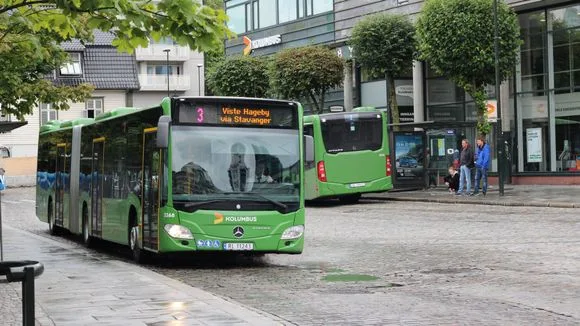Public transport will be free in Stavanger from 1 July. This applies to buses, boats and trains, according to mayor Kari Nessa Nordtun (Ap).
The Labor Party, the People’s Party, MDG, Rødt, the Center Party and SV have agreed to make public transport free, reports NTB, which also quotes Nordtun’s claim that Stavanger is the first out of Norwegian cities.
The mayor writes that they are the first large Norwegian city to fully finance public transport for its residents.
For many, the car is and will still be necessary, but some may be able to get by without a car at all or cut the second car in the household. We hope that the free bus ensures that more people try to travel more by public transport in their everyday lives, preferably in combination with increased bicycle use, says Nessa Nordtun.
But Fredrikstad tried this for a few months, from November 2019 to February 2020, writes Stavanger Aftenblad. Admittedly, there was a decrease in car traffic also after the trial scheme, but that may also be due to the introduction of the toll rings, which happened around the same time.
At the time, half of the respondents said that they would continue to travel a lot by bus even when they had to pay again. This was primarily due to increased toll costs and the fact that it also became cheaper to travel by bus even after the free period than it had been before.
Enthusiasm in Stavanger is great, among the politicians. Rune Askeland in MDG of course sees this as a good climate measure.
Most of all, we want more people to walk and cycle, we believe that more people can take the chance to manage without a car when they know they can combine walking and cycling with public transport on days with bad weather, says Askeland.
Paul Kloster believes that a carrot is better than a whip to force even more climate measures down people’s throats.
Free public transport will make more people try out the bus to and from work, but not least at other times of the day. I am sure that many of those who will now give public transport a chance because of this offer will stay on the bus. When many more people use the bus, it is also easier to expand the route offering, says Kloster.
Sara Mauland (SV) is happy that it will be cheaper to travel.
As the municipality now has increased income due to many more people being back to work, we think it is great to be able to give this money back to people through a reward scheme for more climate-friendly travel, she says.
Free?
Once again, socialist-minded politicians use the term “free”, a term as stupid as zero-emission cars.
Because it will cost Stavanger municipality NOK 200 million a year to cover the costs of this measure. Someone has to pay for this.
Among other things, my family and all my neighbours, who do not use public transport on their way to work. We cycle, walk, or (in my case) get out of bed and find the PC.
Everyone who lives climate-friendly near their workplace, shops and most of what they need must pay. During the day, the buses in the Stavanger area are mostly used by immigrants, many of whom do not work. Both myself and my neighbours have noticed this the few times we have ended up on a bus for one reason or another.
But when I was a conductor in NSB, we were taxed for the benefits of being able to travel for free by train!
There is of course a possibility that the expenses are saved in other areas, something that rarely happens in Norwegian politics at the moment. In any case, any saving will affect someone.
At the same time, it is a requirement that you are registered as a citizen in Stavanger. This means that students who come from other places are not covered by the scheme. Nor do people who live in Sandnes. So then it becomes the case that if someone from Sandnes and someone from Stavanger take the bus together, then one has to pay and the other doesn’t.
Kolumbus operates much of the public transport, and they were not informed in advance, writes Aftenbladet.
This is completely new for us and therefore we cannot say anything about how this might turn out in practice, says communications advisor Morten Nesvik in Kolumbus.
Nesvik cannot answer whether a 10-20 per cent increase in public transport journeys during rush hour will create capacity problems.
County deputy mayor Arne Bergsvåg (Sp) is clear that Stavanger must bear the costs.
It sounds plausible with a free bus. Everything that becomes free is used more, if this leads to us having to run more buses to take the free passengers then we must have a system where Stavanger takes the real costs of this. The county cannot incur additional costs that go beyond the offer to others who travel by public transport in Rogaland, says Bergsvåg.
Many of those who want to use the free bus or train are people who have previously cycled or walked to work.
Ole Ueland (H) is the leader of the transport committee in the county. He is positive about spending funds on public transport, but would rather use the money to increase the number of departures.
We know that frequency is what contributes the most to more public transport passengers.
I have received a number of inquiries from people who live in Stavanger who are very negative about this measure. I myself think this is political idiocy not an unknown phenomenon.
Public transport is already subsidised, now it will be far more expensive. To call it free is an insult to all those who have to pay for the madness, but who do not have the opportunity or need to take a bus, train or boat.

